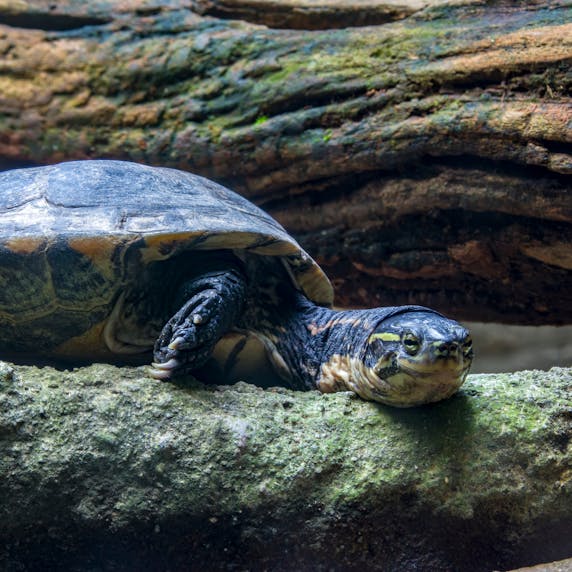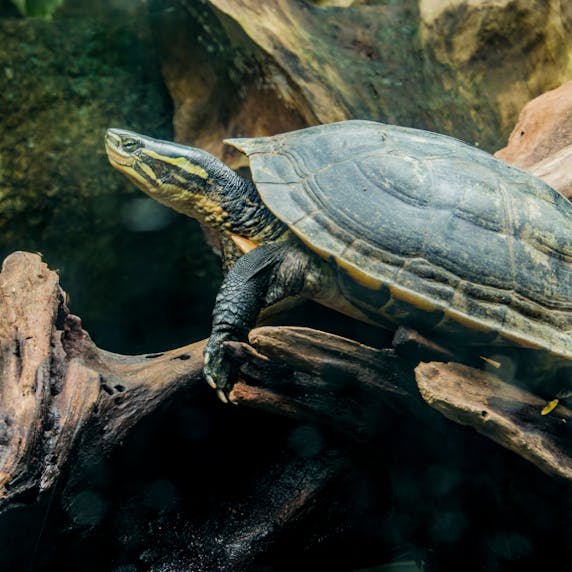
Sometimes, non-endangered species can decline rapidly in a short period of time. In the 1930s, there were so many Vietnamese pond turtles that people even considered them a pest. But from 1941 onwards, none were observed in the wild for a long time. It was not until 2006 that it was discovered that they were not yet extinct. Nevertheless, it is one of the most endangered turtle species in the world. That is why Rotterdam Zoo is dedicated to protect the Vietnamese pond turtle from extinction.
Mauremys annamensis

± 46 years
♀ up to 28.5 centimetres
♂ up to 23 centimetres
♀ up to 2,100 grams
♂ up to 1,750 grams
The Vietnamese pond turtle has a dark brown to grey carapace, with an orange-yellow underside. The bones inside the shell are thicker than in other aquatic turtles. This makes the shells sturdier, presumably to protect the turtles from crocodile bites. It has flippers between its toes. The turtle uses them like "paddles" to propel itself forward in the water.
Like their name suggests, Vietnamese pond turtles are native to lower elevations in eastern Vietnam. The turtles' habitat consists of swamps, lakes, streams and rivers.
During dry periods, wild Vietnamese pond turtles burrow at the feet of bamboo shoots to prevent dehydration. Essentially, they go into a kind of 'summer hibernation'.

Because this turtle is so rare in the wild, little is known about its natural behaviour. The diet of wild Vietnamese pond turtles also remains a mystery. It is believed that they mainly eat small aquatic animals, such as crayfish and worms. They may also eat aquatic plants.

Vietnamese pond turtles generally live alone. They tolerate other turtles in their environment if there is sufficient space and food, but as far as we know, they do not form social bonds with each other.

Little is known about the reproduction of Vietnamese pond turtles in the wild. We do know that they reproduce relatively easily in zoos. This is very good news, as it means that zoos can make a significant contribution to the conservation of this species.

Vietnamese pond turtle mothers lay their eggs in nests made of mud and leaves. Just like crocodiles and other turtles, the sex of a young Vietnamese pond turtle is determined by the temperature of the environment. At temperatures up to around 29 °C, mainly males hatch from the eggs; above that temperature, mainly females emerge.
As far as we know, Vietnamese pond turtles do not care for their young. Young Vietnamese pond turtles seek shelter under aquatic plants or in the mud to avoid being spotted.

Because it is difficult to spot Vietnamese pond turtles in the wild, there are few observations of animals eating Vietnamese pond turtles. Presumably, Siamese crocodiles did pose a threat, but even against these predators, a shell offers a lot of protection.
Unfortunately, that same shell is a weak point against people who hunt the animals when they are hibernating. They stick sharp points into the ground along the bamboo shoots until they hear a sound that sounds like a blow to a shell.

The Vietnamese pond turtle was once a common sight in rice fields. Rice plants grow in water, where the turtles also find their prey. But because the turtles trampled the rice plants, farmers saw them as a threat to their harvest. They therefore decided to hunt the Vietnamese pond turtles. Partly as a result of this, the number of Vietnamese pond turtles in the wild has declined dramatically.
Another important reason why the Vietnamese pond turtle is critically endangered is the trade in Vietnamese markets. Turtle hunters caught the turtles in large numbers and took them to the market, where they fetched high prices. People bought them as pets or even because they believed the shell had medicinal powers. But in recent years, even the turtle hunters have found it almost impossible to find Vietnamese pond turtles. They have been almost completely caught from the wild.

Rotterdam Zoo participates in the European population management programme for the Vietnamese pond turtle. Based on the pedigree of turtles in zoos, the coordinator determines which animals are best paired with each other to produce healthy offspring. These young turtles are then transferred to other zoos to form the next generation. In this way, we are building up a healthy population as a reserve for the wild animals, with the ultimate goal of returning turtles to their natural habitat when conditions there are favourable.

